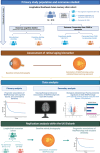A deep-learning retinal aging biomarker for cognitive decline and incident dementia
- PMID: 40042460
- PMCID: PMC11881618
- DOI: 10.1002/alz.14601
A deep-learning retinal aging biomarker for cognitive decline and incident dementia
Abstract
Introduction: The utility of retinal photography-derived aging biomarkers for predicting cognitive decline remains under-explored.
Methods: A memory-clinic cohort in Singapore was followed-up for 5 years. RetiPhenoAge, a retinal aging biomarker, was derived from retinal photographs using deep-learning. Using competing risk analysis, we determined the associations of RetiPhenoAge with cognitive decline and dementia, with the UK Biobank utilized as the replication cohort. The associations of RetiPhenoAge with MRI markers(cerebral small vessel disease [CSVD] and neurodegeneration) and its underlying plasma proteomic profile were evaluated.
Results: Of 510 memory-clinic subjects(N = 155 cognitive decline), RetiPhenoAge associated with incident cognitive decline (subdistribution hazard ratio [SHR] 1.34, 95% confidence interval [CI] 1.10-1.64, p = 0.004), and incident dementia (SHR 1.43, 95% CI 1.02-2.01, p = 0.036). In the UK Biobank (N = 33 495), RetiPhenoAge similarly predicted incident dementia (SHR 1.25, 95% CI 1.09-1.41, p = 0.008). RetiPhenoAge significantly associated with CSVD, brain atrophy, and plasma proteomic signatures related to aging.
Discussion: RetiPhenoAge may provide a non-invasive prognostic screening tool for cognitive decline and dementia.
Highlights: RetiPhenoAge, a retinal aging marker, was studied in an Asian memory clinic cohort. Older RetiPhenoAge predicted future cognitive decline and incident dementia. It also linked to neuropathological markers, and plasma proteomic profiles of aging. UK Biobank replication found that RetiPhenoAge predicted 12-year incident dementia. Future studies should validate RetiPhenoAge as a prognostic biomarker for dementia.
Keywords: Southeast‐Asian; biomarker; cognitive decline; deep‐learning; dementia; prognostic; retinal age; retinal photography.
© 2025 The Author(s). Alzheimer's & Dementia published by Wiley Periodicals LLC on behalf of Alzheimer's Association.
Conflict of interest statement
The authors declare no conflicts of interest. Author disclosures are available in the supporting information.
Figures




References
-
- International AsD . World Alzheimer Report 2018, The state of the art of dementia research: New frontiers. 2018;
-
- Matt Kaeberlein P. Time for a new strategy in the war on Alzheimer's disease. Public Policy & Aging Report. 2019;29(4):119‐122. doi: 10.1093/ppar/prz020 - DOI
MeSH terms
Substances
Grants and funding
- NCSP2.0/2023/NUHS/SMA/National University Health System (NUHS) Clinician Scientist Academy
- KCG/2023/NUSMED/CSDU Collaborative Grant by the National University of Singapore Yong Loo Lin School of Medicine
- MOH-000707/National Medical Research Council
- CG21APR2010/National Medical Research Council
- NMRC/OFLCG/2019/National Medical Research Council
LinkOut - more resources
Full Text Sources
Medical

